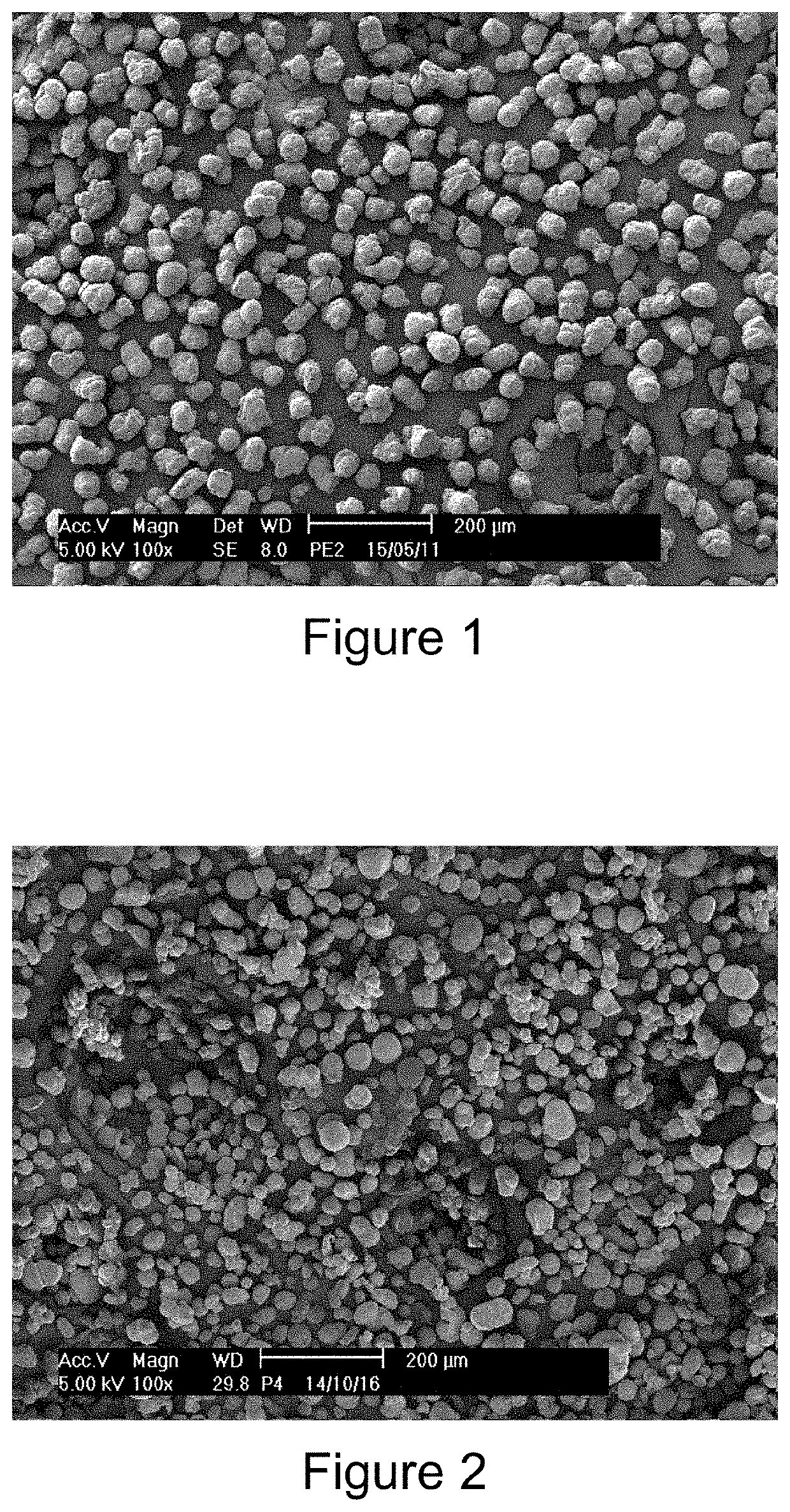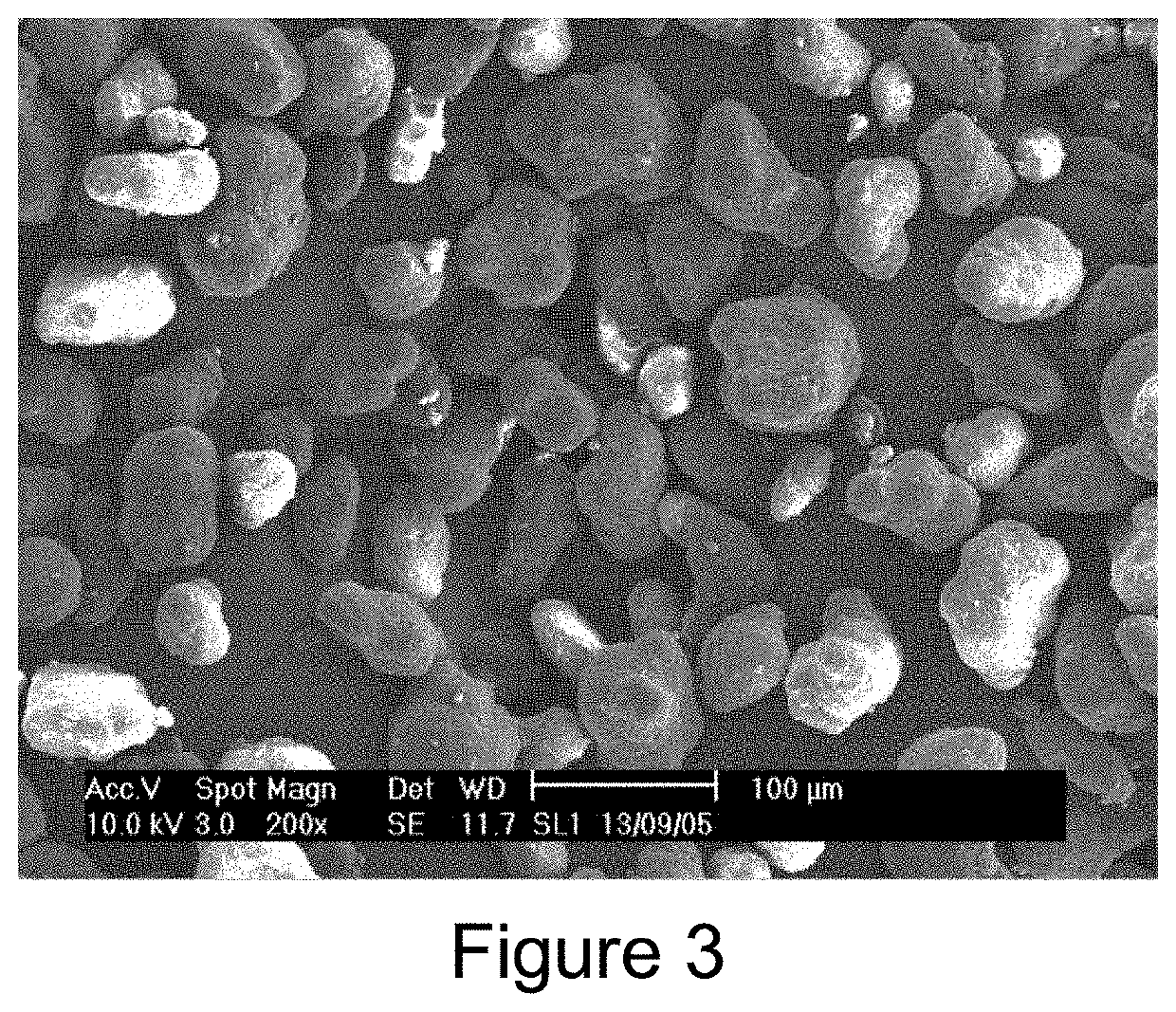Aliphatic polyester resin powder suitable for selective laser sintering and its preparation method
a technology of aliphatic polyester and laser sintering, which is applied in the field of polymer processing, can solve problems affecting the performance of the molded body, and achieve the effects of good biodegradability, moderate size, and suitable bulk density
- Summary
- Abstract
- Description
- Claims
- Application Information
AI Technical Summary
Benefits of technology
Problems solved by technology
Method used
Image
Examples
example 1
[0050]100 parts by weight of poly-L-lactic acid resin and 1000 parts by weight of acetone were placed in an autoclave. A high-purity nitrogen gas was charged to 0.2 MPa; then the autoclave was heated up to 120° C., and kept at this temperature for 30 minutes; thereafter, the autoclave was cooled down to 85° C. at a rate of 0.5° C. / min with cooling water, and held at this temperature for 60 minutes; finally, the autoclave was cooled down to room temperature with cooling water. In the obtained solid-liquid mixture, were added 0.2 parts by weight of antioxidant 1010 and 0.2 parts by weight of antioxidant 168 as well as 0.6 parts by weight of nano calcium carbonate, and thereafter, the material was subjected to centrifugal separation and vacuum drying to obtain a polylactic acid resin powder suitable for selective laser sintering. As measured by a laser particle size analyzer, the polylactic acid resin powder obtained in this example has a particle size of 20-130 μm, and a particle size...
example 2
[0051]100 parts by weight of poly-L-lactic acid resin and 1200 parts by weight of butanone were placed in an autoclave. A high-purity nitrogen gas was charged to 0.2 MPa; then the autoclave was heated up to 125° C., and kept at this temperature for 60 minutes; thereafter, the autoclave was cooled down to 90° C. at a rate of 0.5° C. / min with cooling water, and held at this temperature for 60 minutes; further, the autoclave was cooled down to room temperature at a rate of 0.2° C. / min. In the obtained solid-liquid mixture, were added 0.15 parts by weight of antioxidant 1010 and 0.15 parts by weight of antioxidant 168 as well as 0.8 parts by weight of sodium stearate, and thereafter, the material was subjected to centrifugal separation and vacuum drying to obtain a polylactic acid resin powder suitable for selective laser sintering. As measured by a laser particle size analyzer, the polylactic acid resin powder obtained in this example has a particle size of 45-115 μm, and a particle si...
example 3
[0052]100 parts by weight of polylactic acid resin, including 50 parts by weight of L-polylactic acid resin and 50 parts by weight of D-polylactic acid resin, and 1000 parts by weight of acetone were placed in an autoclave. A high-purity nitrogen gas was charged to 0.2 MPa; then the autoclave was heated up to 130° C., and kept at this temperature for 60 minutes; thereafter, the autoclave was cooled down to 90° C. at a rate of 1.0° C. / min with cooling water, and held at this temperature for 60 minutes; further, the autoclave was cooled down to room temperature at a rate of 1.0° C. / min. In the obtained solid-liquid mixture, were added 0.25 parts by weight of antioxidant 1010 and 0.25 parts by weight of antioxidant 168 as well as 0.5 parts by weight of calcium stearate, and thereafter, the material was subjected to centrifugal separation and vacuum drying to obtain a polylactic acid resin powder suitable for selective laser sintering. As measured by a laser particle size analyzer, the ...
PUM
| Property | Measurement | Unit |
|---|---|---|
| boiling point | aaaaa | aaaaa |
| temperature | aaaaa | aaaaa |
| temperatures | aaaaa | aaaaa |
Abstract
Description
Claims
Application Information
 Login to View More
Login to View More - R&D
- Intellectual Property
- Life Sciences
- Materials
- Tech Scout
- Unparalleled Data Quality
- Higher Quality Content
- 60% Fewer Hallucinations
Browse by: Latest US Patents, China's latest patents, Technical Efficacy Thesaurus, Application Domain, Technology Topic, Popular Technical Reports.
© 2025 PatSnap. All rights reserved.Legal|Privacy policy|Modern Slavery Act Transparency Statement|Sitemap|About US| Contact US: help@patsnap.com


